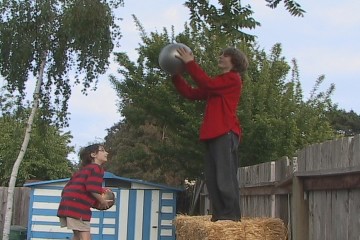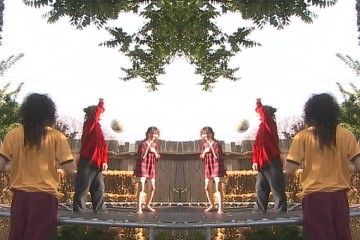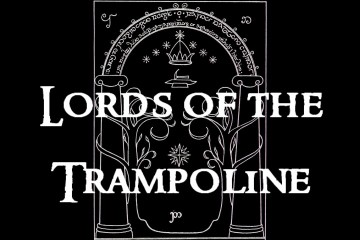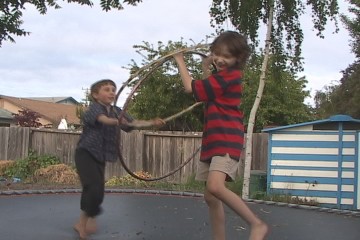Lords of the Trampoline was the third film/DVD project I completed, back in April of 2004. I had recently read The Little Digital Video Book (more about which I shall say in a later posting), which was big on music videos as the ideal beginner project, and so, as I wrote at the time:
Yesterday when Sam and Arthur and some friends were jumping on the trampoline I set up the digital camcorder (which I should write some other things about) on the tripod and just let it film for an hour, occasionally moving it to different parts of the yard for different angles. Then I started chopping up interesting bits of the footage to make a music video to send to relatives and so on. I feel like more of a powertripping egomaniac than ever, it’s great!
 Originally I didn’t have any song at all in mind for the music video, but when Chris started intoning “One ball to rule them all”, and Arthur and Julian were playing with giant rings (OK, hula hoops), then Lords of the Rhymes (which had been getting a fair amount of play at my house back then) became the obvious choice.
Originally I didn’t have any song at all in mind for the music video, but when Chris started intoning “One ball to rule them all”, and Arthur and Julian were playing with giant rings (OK, hula hoops), then Lords of the Rhymes (which had been getting a fair amount of play at my house back then) became the obvious choice.
After I filled up the mini-DV tape, loaded it onto my computer, and started to edit the footage, the first thing I noticed was that the trampoline-dodgeball parts did not make for the most interesting scenes, as when playing trampoline dodgeball most of the time is spent standing around doing nothing — the person on the ground with the ball waits for a good moment to throw it, and the people on the trampoline wait for it to be thrown so they can dodge it. Anyway, I repeatedly went through the footage looking first for bits somehow relevant to the theme or the lyrics, and afterward just for bits of interesting action of one sort or another, and began matching them up to particular points in the music as if I were assembling a jigsaw puzzle.
Another idea I used when deciding where/when to use which bits of footage was to roughly assign characters to the jumpers, for example Sam was Sam and Aragorn, Chris Quickbeam, Arthur Tom Bombadil and Gollum, Julian Bilbo and Merry — I didn’t always organize things this way, but it was one more factor I used when piecing footage and lyrics together.
 One fun thing about doing a music video as opposed to a straightforward record of a performance is that you can enjoy playing around with whatever special effects strike your fancy. As shown in this film still, to go with the lyrics “Mirror mirror on the wall, who’s the greatest hobbit of them all?” I used the “Mirror” video effect, followed by a “Barn Door” transition where the two halves of the mirror image separated and moved apart to reveal Julian as Bilbo Baggins. A more complicated effect was to change Sam’s yellow shirt to blue for the 83 frames shown during the lyrics “bright blue my jacket is and my boots are yellow” by hand-colorizing each frame. Some of the other effects I used were to speed up and slow down the motion, to run part of the footage in reverse, to repeat one short bit upside-down immediately after having run it right-side up, and to zoom in on some still photos I had taken shortly before bringing my camcorder out.
One fun thing about doing a music video as opposed to a straightforward record of a performance is that you can enjoy playing around with whatever special effects strike your fancy. As shown in this film still, to go with the lyrics “Mirror mirror on the wall, who’s the greatest hobbit of them all?” I used the “Mirror” video effect, followed by a “Barn Door” transition where the two halves of the mirror image separated and moved apart to reveal Julian as Bilbo Baggins. A more complicated effect was to change Sam’s yellow shirt to blue for the 83 frames shown during the lyrics “bright blue my jacket is and my boots are yellow” by hand-colorizing each frame. Some of the other effects I used were to speed up and slow down the motion, to run part of the footage in reverse, to repeat one short bit upside-down immediately after having run it right-side up, and to zoom in on some still photos I had taken shortly before bringing my camcorder out.
 When making a DVD of a performance, what I often do for the credits is to continue to run the camcorder following the bows and any final speeches (so you get nice authentic scenes of audience members walking around congratulating the actors, actors clowning around, and so on) and then run that footage with scrolling credits over it and the audio replaced by an appropriate song. Well, with Lords of the Trampoline I did sort of the opposite — I kept the audio of Arthur singing “We Will Rock You” while Chris talked about the Balrog, but replaced the video with scrolling credits over this reverse image of the Moria Gate.
When making a DVD of a performance, what I often do for the credits is to continue to run the camcorder following the bows and any final speeches (so you get nice authentic scenes of audience members walking around congratulating the actors, actors clowning around, and so on) and then run that footage with scrolling credits over it and the audio replaced by an appropriate song. Well, with Lords of the Trampoline I did sort of the opposite — I kept the audio of Arthur singing “We Will Rock You” while Chris talked about the Balrog, but replaced the video with scrolling credits over this reverse image of the Moria Gate.
I finished making the Lords of the Trampoline music video on May 19, 2004, a few weeks before the first annual AFE Follywood festival celebrating student (and sometimes parent or alumni) films and filmmakers, and sent a copy to the organizers. Responding to their concerns about length (films were generally supposed to be under five minutes) and language, I made a six-and-a-half-minute Follywood-cut version of the original seven-minutes-and- ten-seconds video, with the Lords of the Rhymes’ occasional bits of profanity bleeped out courtesy of yelled “BLEEP!”s by Arthur. It was a hit, and through one of those odd chains of events we often find ourselves in, even resulted in my (sadly now defunct) square-dancing group getting to dance in the Santa Cruz Pride parade that year.
 For me both versions are a wonderul window back to a joyful afternoon five and a half years ago, when Arthur and Julian were definitely much shorter, and when I could see Sam basically every single day instead of just during college breaks!
For me both versions are a wonderul window back to a joyful afternoon five and a half years ago, when Arthur and Julian were definitely much shorter, and when I could see Sam basically every single day instead of just during college breaks!
Revisiting Lords of the Trampoline for YouTube
So again, Lords of the Trampoline was my third video project, back in April of 2004 when I had only had my camcorder/software setup for about two months. I had gotten a 160GB external firewire drive for $225, which at the time seemed incredible to me both in capacity and price considering that I can well remember when 10MB drives were going for about $2000. However, with prerendered files eating up about 4GB for every 20 minutes of raw video from my camcorder, as you can imagine it still wouldn’t take long to fill it up, especially with all the in-progress projects I keep racking up in addition to the completed ones. So how I dealt with the disk-space issue (besides eventually adding more and larger external drives one by one) was first, to always save my Mini-DV tapes so I could reload them onto the computer another time if necessary (obviously it saves a small amount of money to reuse tapes, but when I’ve occasionally gotten a tape with dropped frames or other problems it’s been such a headache that I don’t want to risk more of that kind of thing by reusing tapes), and second, to delete the raw video files from the external drive once some months had passed since I’d completed a project, so that it didn’t seem like I would be going back to make any additional corrections or other changes.
Then, years later, along came the rise of YouTube, and wanting to upload some of my old music videos to YouTube suddenly gave me a reason to want those raw video files back on my system again so I could rerender the music videos for YouTube as opposed to ripping them from the DVDs at a presumably lower quality. But I had some reasons to procrastinate on this: First, although I had indeed saved all my tapes, they were horribly disorganized — just set here or there all over the place. Second, I had never actually tried reloading a tape to use with an existing project after having deleted the raw video files in the first place, so I didn’t know whether after doing this everything would continue to sync up perfectly, or whether there might be some variations in video capture instances that would throw things off, especially considering that I had originally been using Vegas 4 with Windows 98SE but was now using Vegas 8 with Windows Vista (so nice to be able to render projects in a short time without crashing, instead of overnight and crashing half the time).
So, not knowing where exactly most any individual tape or set of tapes was, and being afraid that there might be some big problem with getting reloaded tapes to sync up with original project files, I kept putting it off. But then finally I was thinking about Lords of the Trampoline, and that I should write a blog entry about it (which then of course I would want to be able to link to both versions of the video on YouTube), so I took the plunge.
As it had only been my third completed project, the tape was actually easy to find, because (duh!) it was in the first place I had started sticking my used tapes. I really need to come up with some filing system for my tapes — maybe just as simple as putting them in their own file folders in my general filing cabinets, as opposed to getting or coming up with some kind of dedicated tape-storage solution. This would particularly make sense for plays, because then the tapes would just be in the same folders I’m already using for the programs, posters, etc. for those plays.
As I reloaded the tape onto one of my external drives I was pleased to see that despite five and a half years having passed since filming there were no dropped frames or other errors, but then unfortunately when I played the video within the Vegas 8 editor I saw that many of the clips were just not correct. When I looked at the properties for some of the clips I saw that all the clips I had taken from the first raw video file were correct, whereas clips from subsequent files were not, so the problem did look like Vegas 4 vs. Vegas 8 and/or Windows 98SE vs. Vista chose slightly different file sizes when breaking captured video into ~20-minute chunks. So I re-reloaded the tape onto my old Windows 98SE system (luckily still in use as my network server, among other things) using Vegas 4, copied the files to my Vista system, reloaded in Vegas 8, and almost all was fine — I noticed one more Vegas 8 vs. Vegas 4 difference, which was that the still photos I had used were now appearing with thin black bars on either side, requiring me to uncheck the “Maintain aspect ratio” box for each one. I rerendered both the original and the Follywood-cut versions as 720×480 MPEG-2 files at a constant bit rate of 9,800,000 with included audio stream, and uploaded them and they looked good — it’s great that YouTube has moved way beyond the days when for best results you had to optimize for 320×240.
And so it can be done, and so I’ll be able to rerender and upload my/our Prospero’s Island and Monkeys Don’t Wear Vests music videos at some point in the future, with presumably no problems at all other than being able to locate the tapes and the time!
(Our Follywood music videos I’m Henry IV I Am and Meg’s Beach Party are already on YouTube.)
updated January 20, 2012








{ 0 comments… add one now }